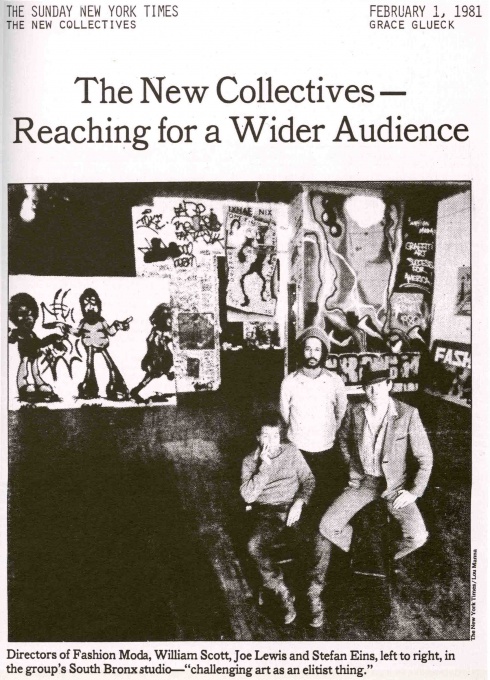Reaching for a Wider Audience – Grace Glueck (1981)

In this 1981 New York Times article, Grace Glueck looks at three NYC-based artist-run organizations that “aim to reach a wider, less-sophisticated audience than the upper-middle-class art patrons.” Fashion Moda, Taller Boricua, and Collaborative Projects, Inc. (CoLab) were part of a “growing movement of artists who work[ed] collectively, outside of the conventional art world boundaries.”
Fashion Moda, started in 1978 by Stefan Eins, and co-run by William Scott and Joe Lewis out of a South Bronx studio, sought to, in the words of Eins, “challenge the assumption that art is an elitist thing.” A self-described “Museum of Science, Art, Technology, Invention, and Fantasy,” the group organized exhibitions of work that integrated local as well as more established artists.
Describing the work of both Fashion Moda and CoLab, Glueck notes that the two groups were “influenced by comic strips, commercial signs and symbols, street culture and the energy of Punk Rock.” CoLab, a group of approximately 50 young artists, would gain recognition for their “much-talked-about Times Square Show in a scruffy 41st Street massage parlor.” Taller Boricua, the oldest of the three groups, was an organization of 10 Puerto Rican artists dedicated to providing, “a community-based cultural center promoting Puerto Rican culture and aesthetics.” Members of this group had previously been involved in the Art Workers Coalition (AWC).
The article appeared during the run of an exhibition at the New Museum in which all three groups were to have participated, though CoLab would later decline to participate “on the grounds that [the group] stood to gain less from the collaboration than its host.” Titled “Events,” it manifest as a series of three individual exhibitions coordinated and organized by each participating artist group and took place Dec. 1980 – Mar. 1981.
Glueck’s article is a timely reminder that the “pluralist” imperative to integrate disparate modes and sites of production as well as reach non-traditional (and local) art audiences is part of a larger history.
SOURCE: Grace Glueck, “The New Collectives–Reaching for a Wider Audience,” The New York Times (February 1, 1981).